July has featured very heavy melting of the Arctic sea ice in the Siberian regions. In the western parts, the Laptev Sea will be ice-free this month, while the rest of the Arctic Ocean gets ready for the strongest part of the melt season from August to September.
The Arctic sea ice extent was running largest in the past few years during Winter 20/21 and into early Spring 2021. But pressure changes in the Arctic have now created a faster melt phase, with new weather patterns coming in August, that can push the sea ice extent lower than last year.
This article is very rich with high-quality graphics. So even if you don’t like long reading, there is still plenty of information on the vivid graphics that tell the tale of the Arctic circle.
ARCTIC SEA ICE – 2021 SEASON
The Arctic region is actually just one large ocean and has no true large-scale landmass. It is the smallest and shallowest of the world’s five major oceans, and it is also the coldest. This is also the only ocean, which is smaller than the largest country in the world by area (Russia).
The image below shows the Arctic ocean, as it would look without water, revealing a very complex underwater terrain. You can see the main regions of the Arctic ocean, each with its own set of unique weather and oceanic properties. The graphic is from one of the more recent Arctic ocean studies.

The Arctic sea ice has its own seasonal cycle and it can be seen in the image below from the Arctic-ROOS system. It shows the sea ice extent change over a one-year period. The melt season usually starts in late March, lasting well into September where a minimum is reached.
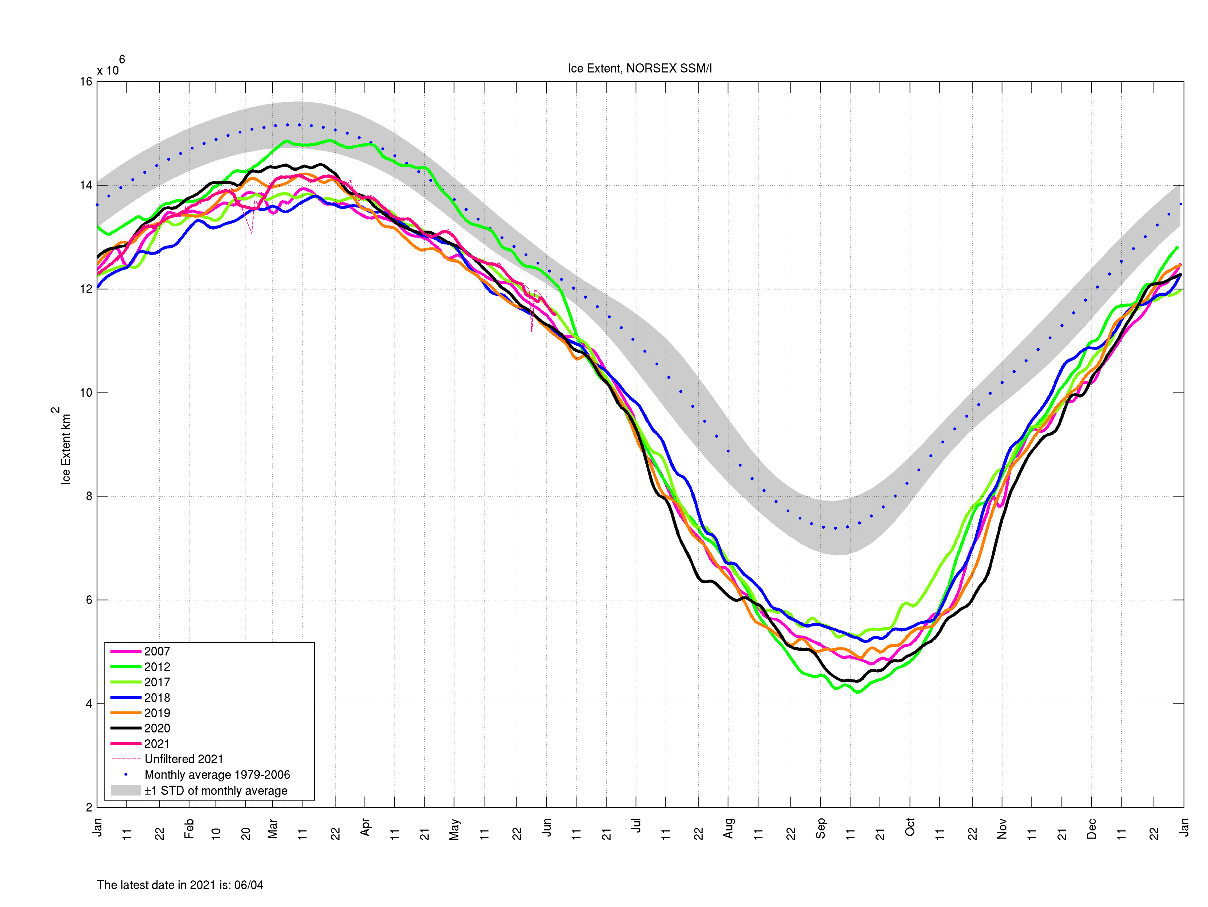
The graph above shows the last few years of data, where we can see the 2020 Arctic ice extent was second-lowest, only behind 2012, which still holds the record for the lowest ice extent since satellite measurements began.
The seasonal sea ice melt cycle is driven by seasonal temperature changes. When the days start to get longer and the solar radiation over the Northern regions gets strong enough, the temperatures rise and the melting process slowly starts on the outer edges first.
During Summer, the Arctic region has sunlight for 24 hours a day, which means a near-constant sea ice melt process. The image below shows the tilt of the Earth’s axis and the angle of the incoming sun rays during a North Hemisphere Summer Solstice.

We produced a high-resolution video, which shows the 2021 sea ice maximum that was reached in March, and the melting since then when temperatures began to increase. Take notice of the constant strong movement of the icecap, influenced by the ocean currents and also strong weather/wind dynamics.
Below we can see the sea ice maximums over the last 17 years, and how the 2021 sea ice maximum compares. It was actually higher than some of the recent years, and around the average for the 2010-2019 period. Note that this is from the JAXA dataset, which can be slightly different than the data used on the previous graphic. This graphic is by Zachary Labe.

Looking at current conditions from NSIDC, we can see the extent of the sea ice, compared to the long-term average (orange lines). The largest deficits can be found in the Siberian regions of the Laptev Sea, Kara Sea, and also in the Barents Sea, and the Labrador Sea.

The line graph below shows the latest Arctic sea ice extent, which is running below the long-term average. The dashed line is the 2012 melt season, which in September ended up with the record lowest sea ice extent. currently, the 2021 season is running close to 2012. But the 2012 melt season began with rapid melting in early August.

The current sea ice extent is slightly over 6.5 million square kilometers in area, which is around 1.8 million square kilometers below the long-term average. It is still running over half a million square kilometers larger than this time last year. But we have seen a temporary reduction in the melting strength from late July to mid-August last year.

SEA ICE CONDITIONS IN PERSPECTIVE
Before looking at the latest high-resolution maps of concentration and thickness, it is good to have a perspective, where the current season stands compared to previous years/decades. All graphics in this segment are provided by Zachary Labe.
Currently, the 2021 Arctic sea ice extent is ranked as the 5th lowest extent in modern times. You can see the lowest 4 years in red on the graph below, and 2021 in yellow. These are rankings for late July, so a lot can change in the coming weeks. 2012 was only the 3rd lowest at this time, and continued on to reach a record low extent in September.

Looking at the sea ice thickness, it was running low in early July, while even being second thinnest during the Winter 2020/2021. You can see the very obvious thickness reduction over the past 40 years.

The current sea ice extent anomaly shows the deviation from the 1980-2010 average extent. In late July, there has been some reduction in the deviation from the norm, as back in early July we had the second-lowest deviation in the past 42 years.

Looking at the Arctic basin sea ice, where the main seas are included, the melt is progressing at a decent pace, holding to the lower end of the spectrum. You can see on the graph how the older years (violet) started the melt much later and melted way less than recent (white-blue) years.

The one exception is of course the Laptev Sea, which is melting at a record pace this season. Last year (yellow line) it melted entirely for only the second time in known records. This year the Laptev sea ice melt began early and is currently at the second-lowest extent for this time of year.
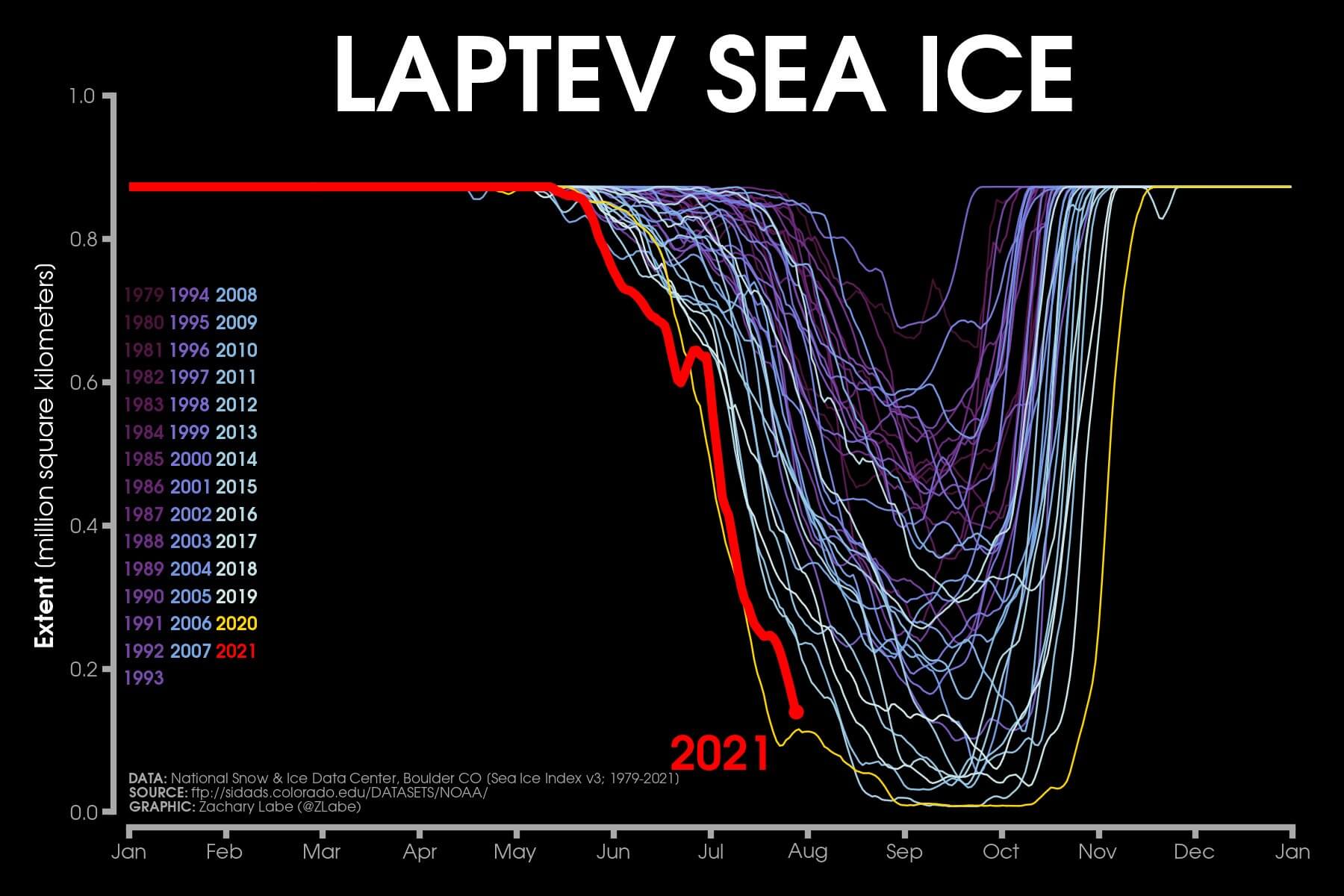
The Laptev Sea is expected to become ice-free this August, for only the third time in the past 42 years. It could also reach the fastest ice-free date, before mid-August.
Overall, you can see the daily sea ice extent change on the graph below. This is useful to see if on average the Arctic icecap is melting or also gaining some ice area. Strong overall melt is ongoing since April, with a few days in between where the ice extent has still increased, due to weather conditions and ice movement, rather than actual new ice being formed.
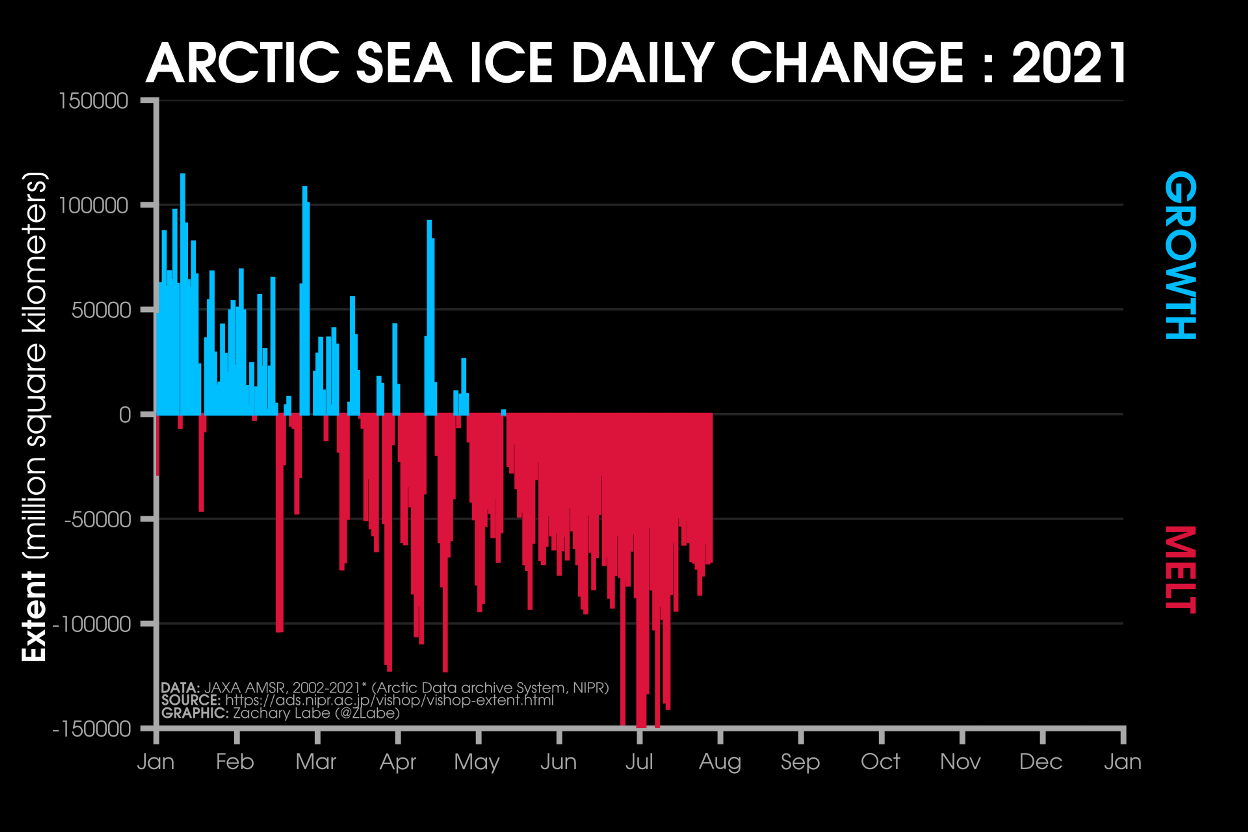
Looking closely at July, we can see the very rapid daily melting in the first half of the month. It was slightly relaxing towards the end of the month, as the weather patterns were in transition.

In the last 5 days, most Arctic regions experienced melting at a steady pace. The fastest melt was observed in the Siberian regions of the Kara Sea and the Laptev Sea, and in the Canadian Basin. Hudson Bay is seen to have some slight sea ice increase, but this could also be a change due to ice movement.

We will now turn away from lines and bars and towards some actual high-resolution maps of sea ice concentration and thickness.
SEA ICE CONDITIONS AND FORECAST
Arctic sea ice is much more than just extent and area. Below you can see our graphic, which shows the sea ice concentration. It tells us what is the fraction of the sea ice in the ocean. We can see the strongest concentration in the central regions, reducing towards the outer regions which are going to melt first.

Another important parameter of the Arctic sea ice is of course its thickness. It reveals where the icecap is thicker, and where it is thinner and thus much more prone to melting. The central regions are remaining quite thick this season, but the maximum thickness is somewhat lower.

The thinner ice can be of course found on the outer edges, which are always the first to melt. One important thing to take away from this image is how thin the icecap really is, compared to its large size, only up to 4 meters (13ft)
Another important parameter that can affect the melting process is the movement of the ice. The graphic below shows the latest sea-ice velocities and directions. We can see that the icecap spins mostly clockwise, faster in the western regions.
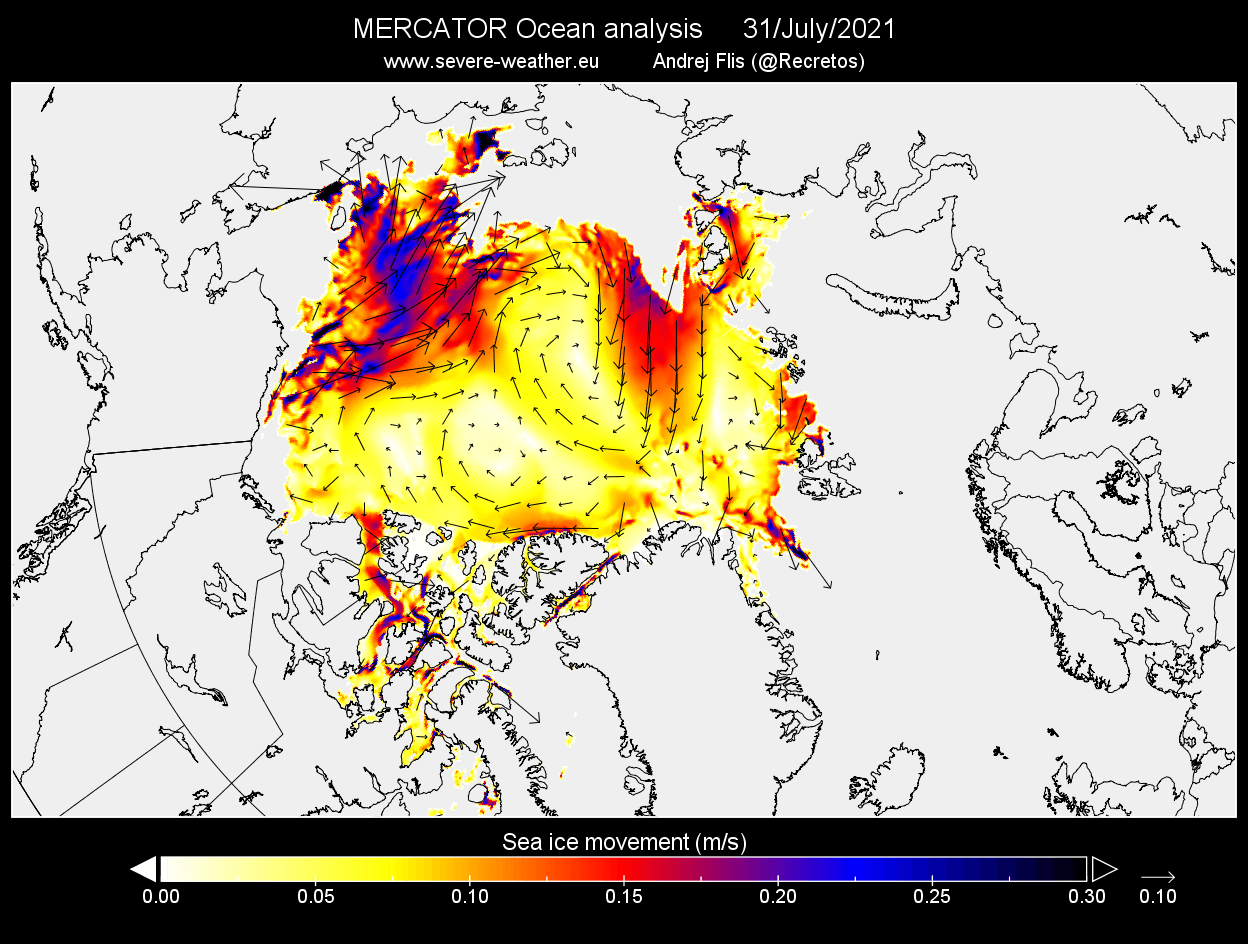
Looking ahead in early August, we can see a strong high-pressure area building over the western Arctic and Siberia. low-pressure systems will form around it, creating a version of the cross-polar flow. This will bring warmth and moisture into the Arctic which can accelerate the melting process.

Looking at the air mass temperature anomaly forecast below, we can see much warmer than normal temperatures over central Siberia and along the eastern edge of the Arctic Ocean. Strong southerly winds will extend these warmer anomalies deep across the Arctic, all the way to Canada and Alaska.
A cold area will develop over northern Canada and the Aleutians. This is because of the strong high-pressure area that is transporting cold air out of the Arctic region, replacing it with warmer air.
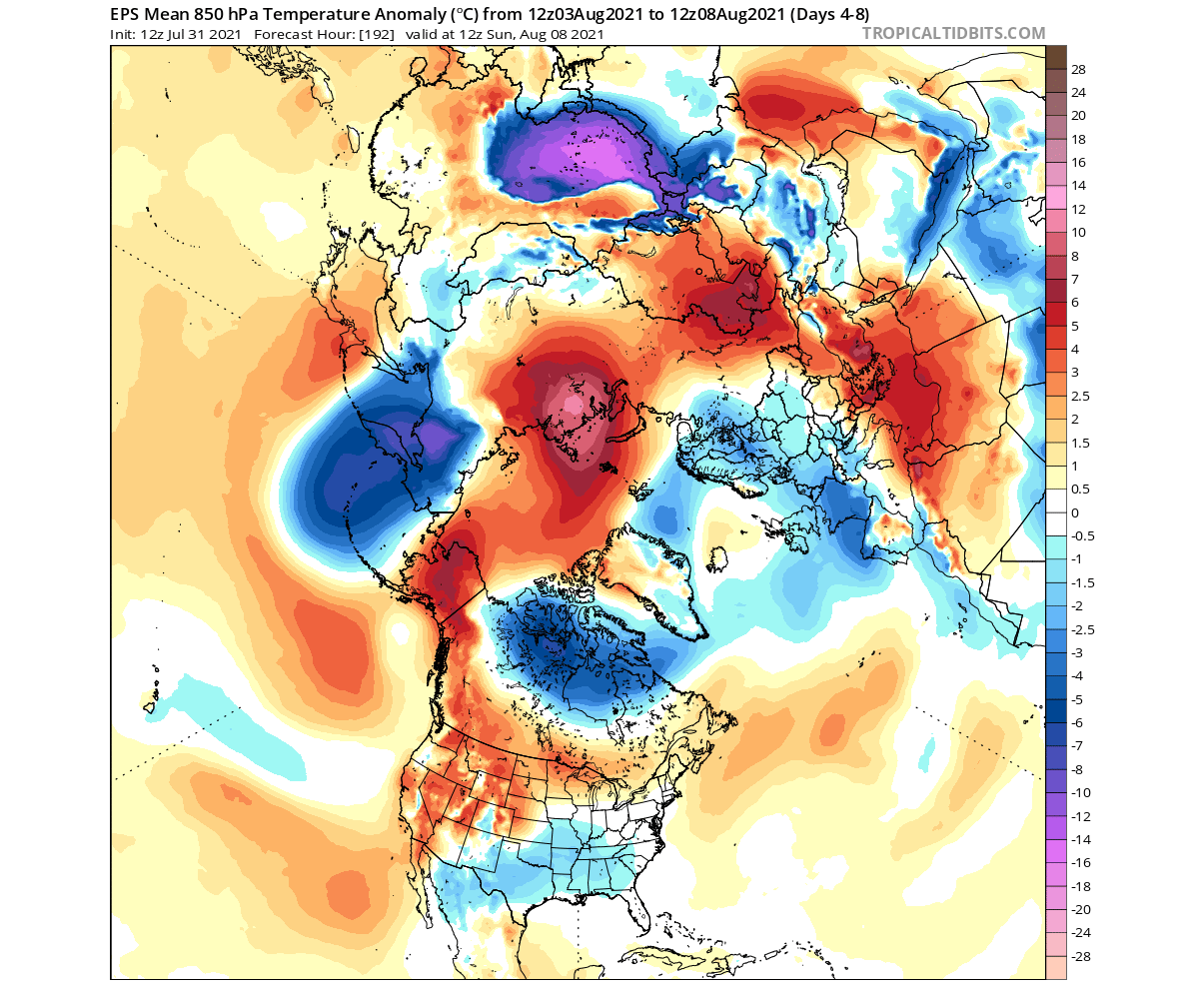
Looking at the surface temperature anomalies, we can see over 10°C warmer than normal temperatures in the Siberian region. The surface anomalies will not be that much warmer over the Arctic Ocean, where the airmass anomaly (seen above) is more important.

Not only air temperatures, but ocean temperatures are also warmer than normal, especially in the Siberian sector and around Greenland. Warmer ocean temperatures can contribute to faster and earlier sea ice melt, especially on the outside edges, where waters are above the melting point earlier.

Knowing the weather forecast and the state of the ocean, we can look at the forecasted changes of the Arctic icecap in the first third of August.
The Arctic sea ice concentration change forecast does show the reduction in concentrations around most of the icecap (yellow-red colors). There are strong dynamics in the western side in the Chukchi Sea and the East Siberian Sea, where the strongest loss of sea ice extent is expected due to the weatehr conditions.
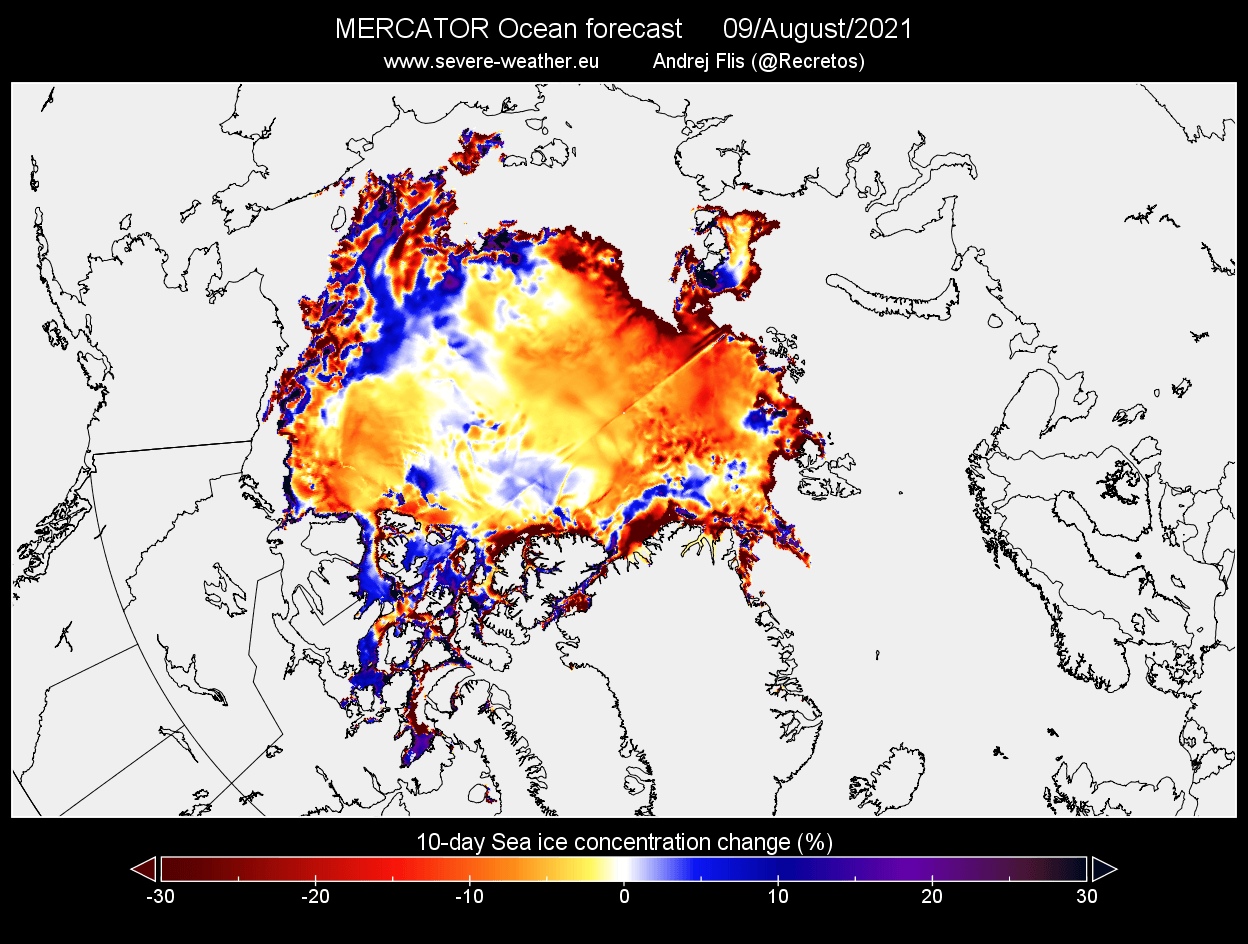
Overall, not every reduction in concentration over the central regions is melt, as the icecap is constantly moving, changing its concentrations. We can see the blue area of increased concentrations in the western edge, where strong weather dynamics are quickly changing the concentrations.
Looking at the Arctic sea ice thickness forecast below, you can see most of the icecap is reducing in thickness. You can nicely see the “stripes” across the icecap, which are due to the movement of the sea ice. They show where the sea ice compacts together or moves away, increasing/decreasing thickness and concentrations across the icecap.

WEATHER PATTERNS OVER THE NORTH POLE
We know that the weather patterns have the main influence on the movement and of course melting of the sea ice. The weather patterns over the Arctic Circle can change quickly and last for an extended period of time.
Below we can see the average pressure anomaly in the first half of July. It shows a dominating low-pressure area over much of the Arctic region, yet the sea ice was still melting at an increasing pace.

We can try to understand that by also looking at the temperature anomalies for the same period. A low-pressure area spins counter-clockwise, and can also transport warmer and moist air into the Arctic Circle. Moisture is also very important, as it can affect the downward longwave radiation, thus being an important piece in the energy budget/system in the Arctic.
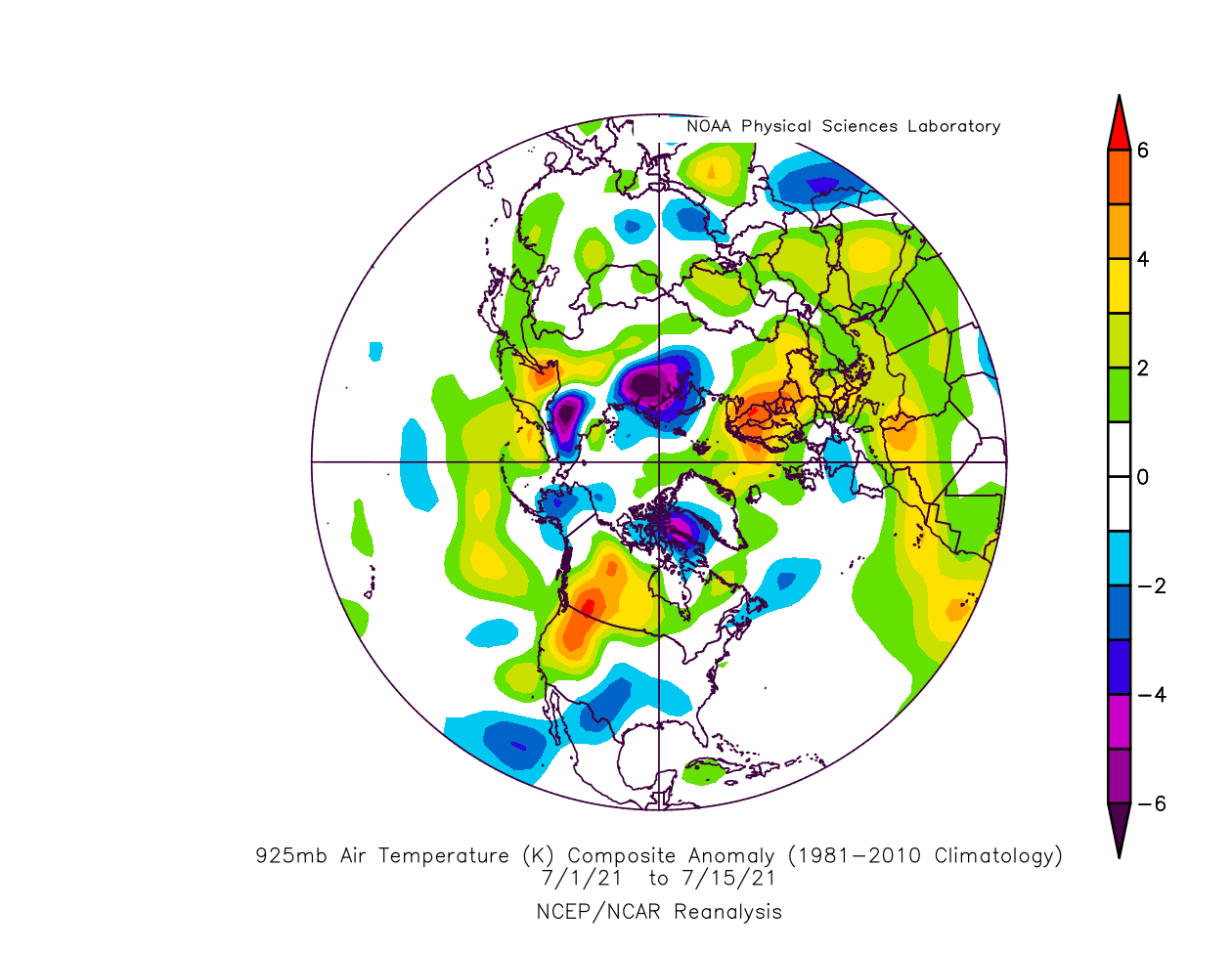
In the second half of July, we witnessed a slight weather pattern change over the Arctic. The strong low-pressure system was replaced by a high-pressure system. The old low-pressure area has moved further east, towards Scandinavia and eastern Siberia.

The pressure difference between the “low” and “high” systems created an airflow from central Siberia into the Arctic. But the Siberian air is drier than from the North Atlantic, so despite warmer temperatures, we did no see a rapid increase in the melt pace.
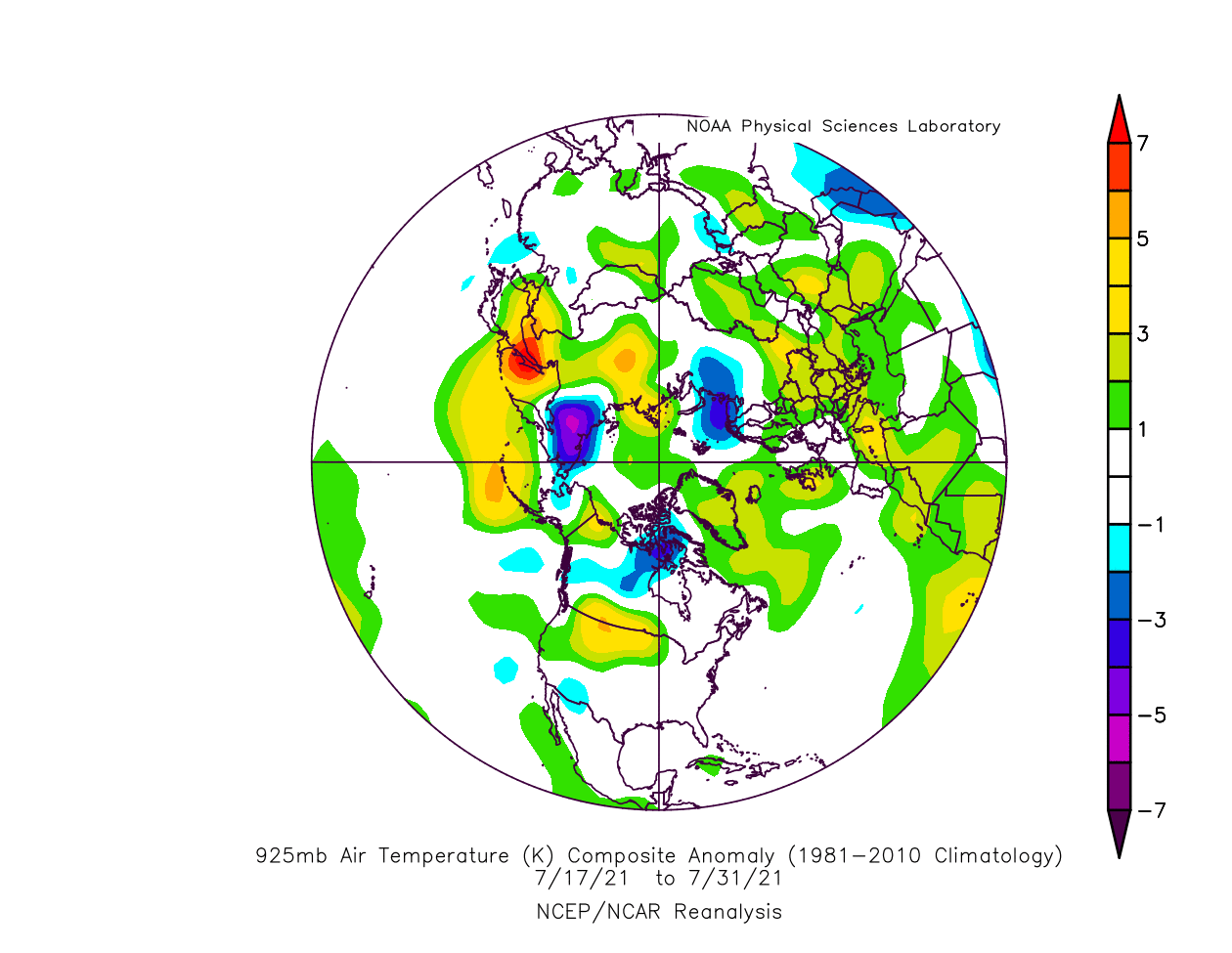
Looking at July as a whole, there were no strong temperature anomalies. We can see warmer Scandinavia and eastern Siberia, and colder than normal surface temperatures in northern Canada and central Siberia.

Looking at the sea ice motion again, you can see that around a month ago, it was spinning in a completely different direction. This was due to the strong low-pressure area over the Arctic, forcing its circulation onto the icecap. Counter-clockwise movement can power the melting process by affecting the compactness of the ice sheet.

Below we have a very special graphic, which shows the age of the sea ice. Not all ice is of the same age, as some are the newly formed “one year ice”, while some sea ice can be over 4 years old. The age of sea ice is very important, as the older it is, the harder it melts.
Over the years, a lot of the older sea ice was lost, replaced with much weaker one-year ice. The graphic below shows the age of the sea ice, comparing 1985 and 2019. You can see how much of the old sea ice (red) was lost in the last 35 years.
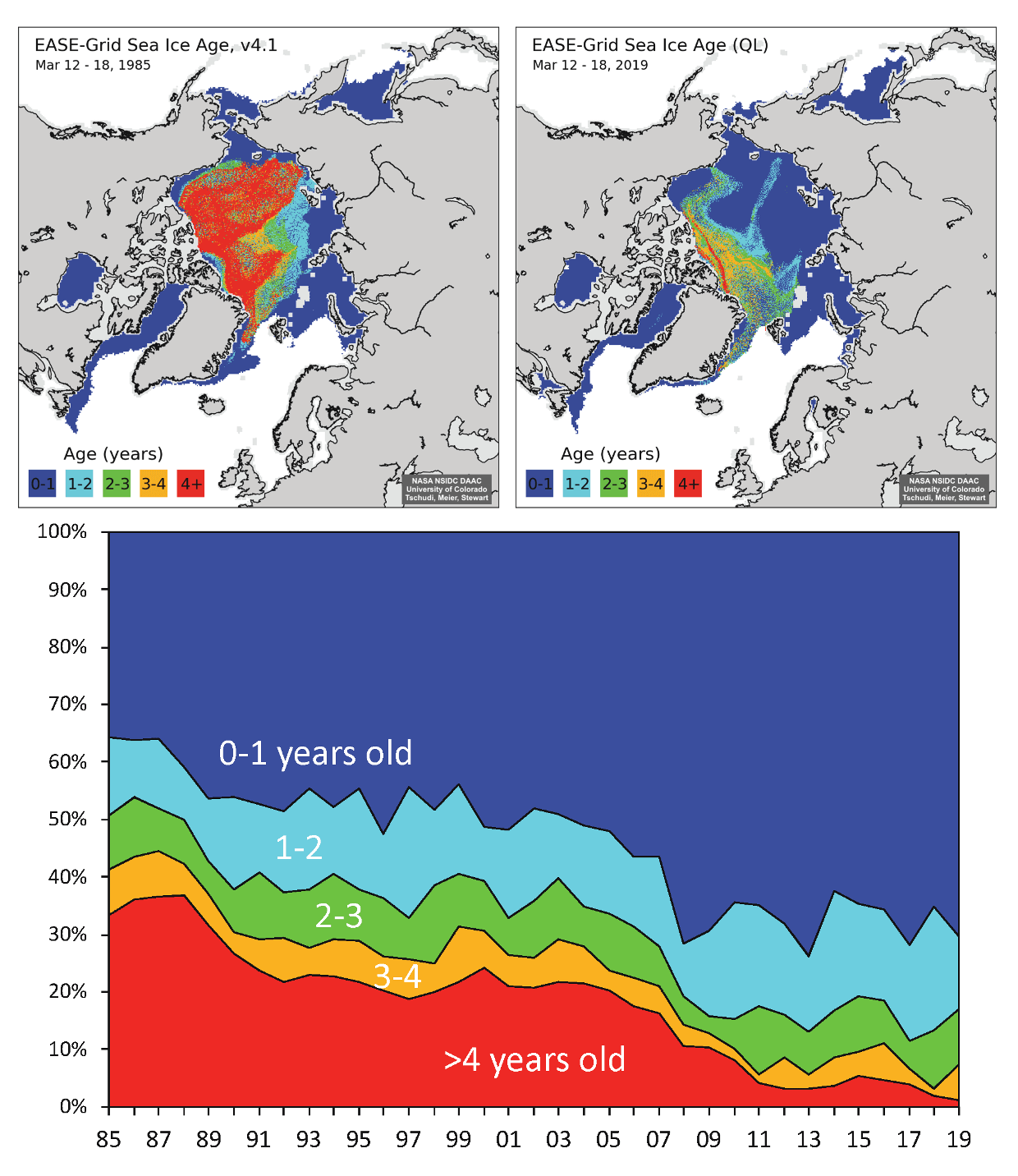
The bottom half of the graphic above shows the percentage of sea ice by age. It is obvious how much the old sea ice has reduced, especially in the past 15 years.
Looking at the sea ice age in late June, we can see very little old ice has remained. Some of it was actually spread out into the Beaufort Sea during winter. That is bad, as the older sea ice is more vulnerable to melting when it is spread out and not as compact.

The satellite image below taken in June by the NASA-Terra satellite shows this old ice in the Beaufort sea, seen more white-bluish towards the right of the image, while the newer/younger sea ice is darker/grayish in color towards the coast.

Temperature anomalies in June were more intense than in July. Warmer than normal temperatures were dominant around the Siberian side of the Arctic circle, while colder air moved into Greenland and northern Canada.

Overall, the June trends for sea ice concentration are not very promising, with major reductions all around the icecap edges. The strongest sea ice reduction trend is seen in the Kara Sea, followed by most of the other icecap edges in the North Atlantic ocean.

The June extent trend for the past 40 years is also showing a major reduction. For the past few years, we have not seen a continued drop in June sea ice extent, but the long-term trend is in an obvious direction.

ARCTIC SEA ICE VOLUME
During winter 2020/2021, the Arctic sea ice volume was running below normal, continuing from the low volume in Autumn 2020. It reached a good peak in April but is currently below normal for late July, tho still running higher than the last few years.
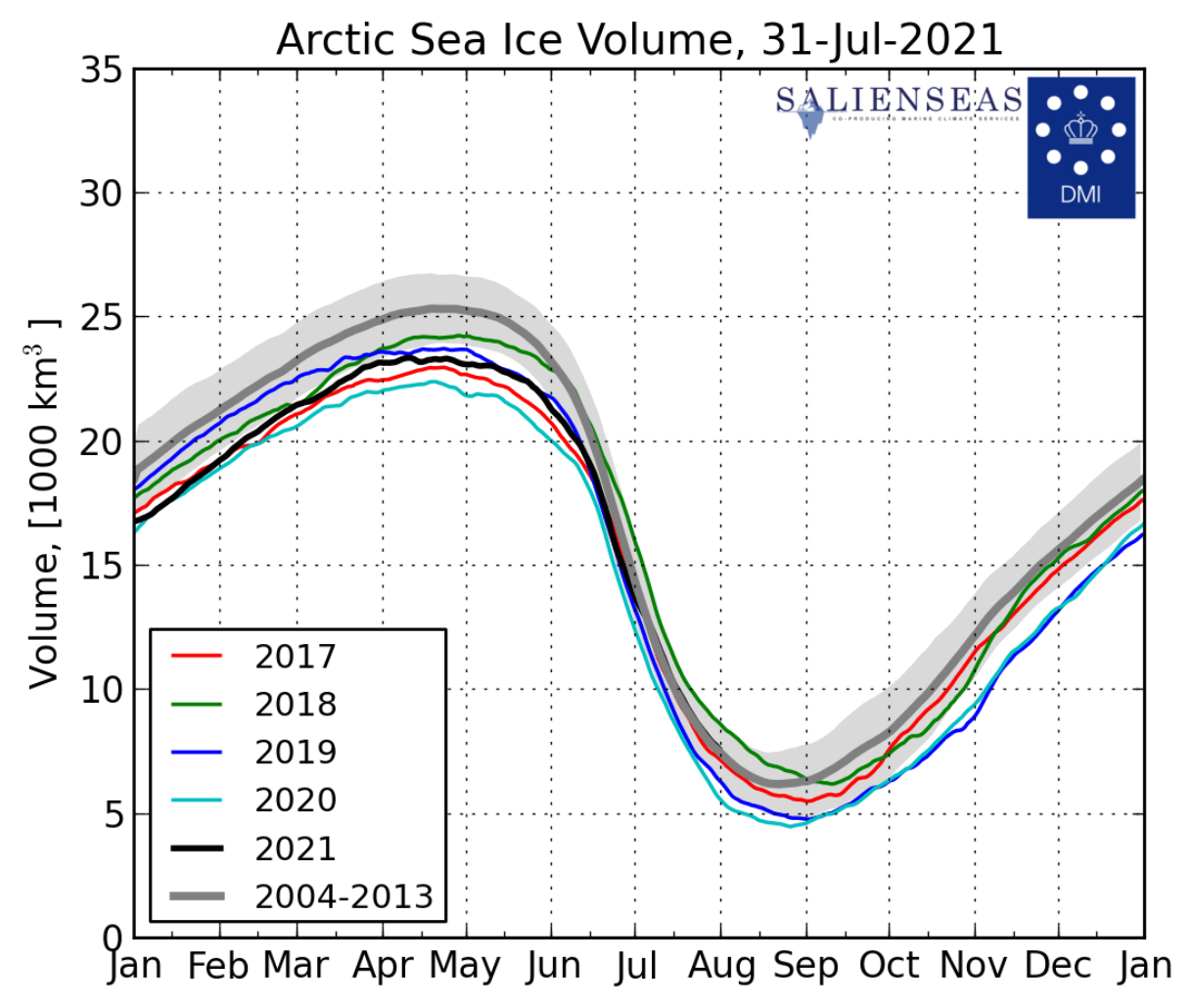
Looking at the past 40 years, we can see an obvious negative trend in the Arctic sea ice volume. The sea ice volume is decreasing quite rapidly, but if we look closely at the last 10 years, there is perhaps a slower decline than in the early 2000s. In the end, the long-term trend is perhaps more telling. It is on a stable decline, corresponding to the rise in temperatures, especially over the north polar regions.
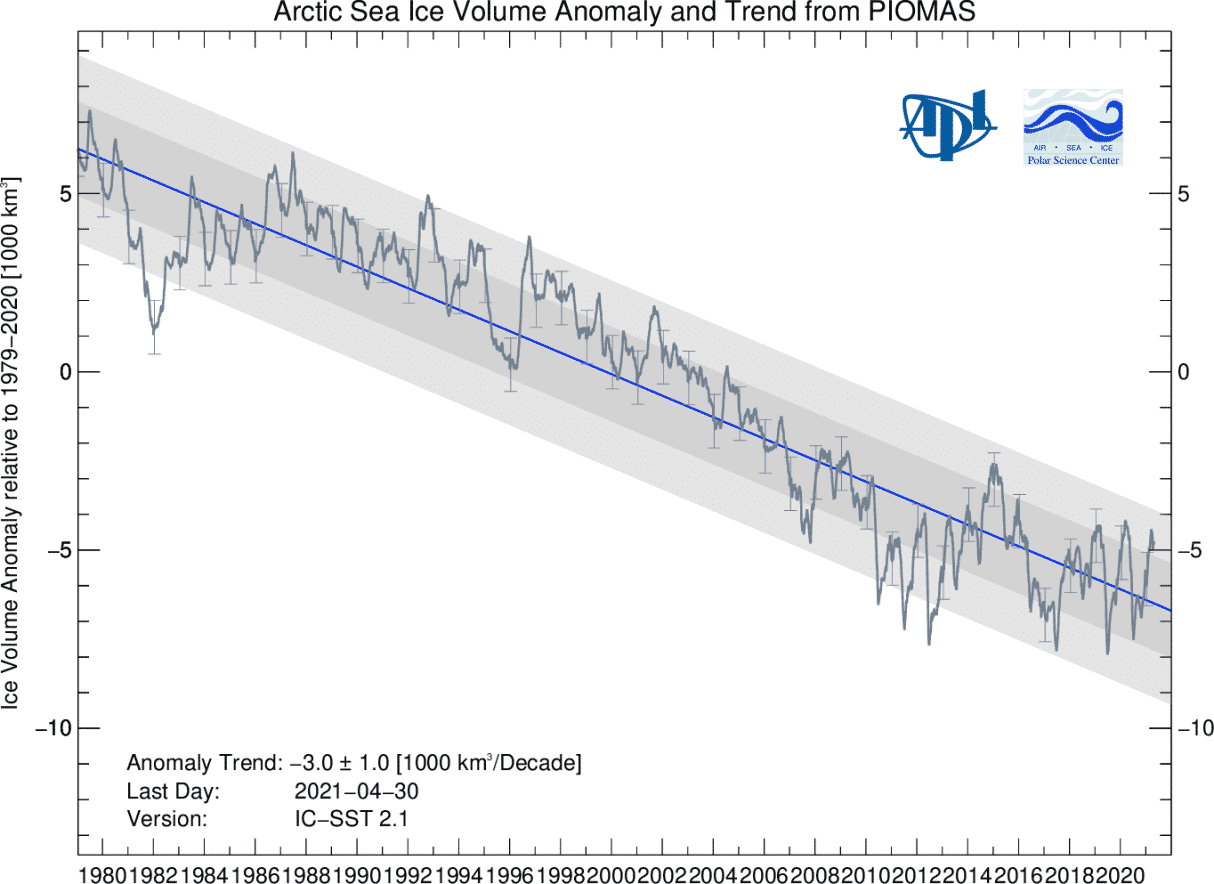
Sea ice volume reduction of course means that there is less sea ice, not just by area, but also by thickness. Below we have an image, which shows the average sea ice thickness in September, which is the peak of the melt season. You can see a very obvious reduction in sea ice thickness, especially in the last decade, where the icecap no longer touches the Siberian side.

ARCTIC SEA ICE MONTHLY FORECAST
Looking over the entire month of August, the latest monthly forecast below shows that it will be dominated by higher pressure over the Arctic regions, especially over Siberia. This setup can promote warmer temperatures and more moisture transport into the Arctic region.

The temperature anomaly forecast shows much warmer than normal temperatures extending from Siberia into the Arctic Circle all the way to Greenland. This will speed up the melting process on the outer edges of the icecap, but we do not have warmer than normal temperatures on the Canadian arctic side.
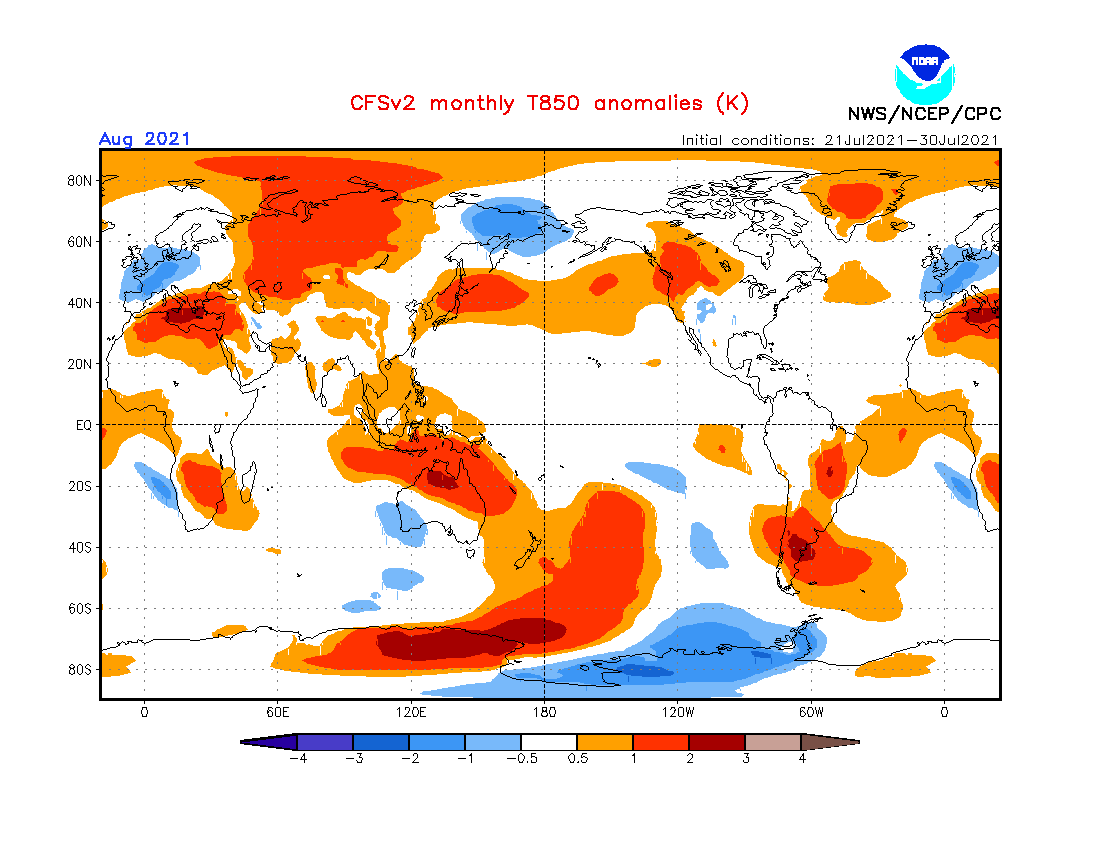
Looking at the Arctic sea ice extent forecast graph, it is quite interesting to see. The same model as above predicts the peak of the melt season with well below 4 million square kilometers total extent, nearing 3 million square kilometers. This would be a new lowest record, but still far away from a “Blue Ocean Event”.
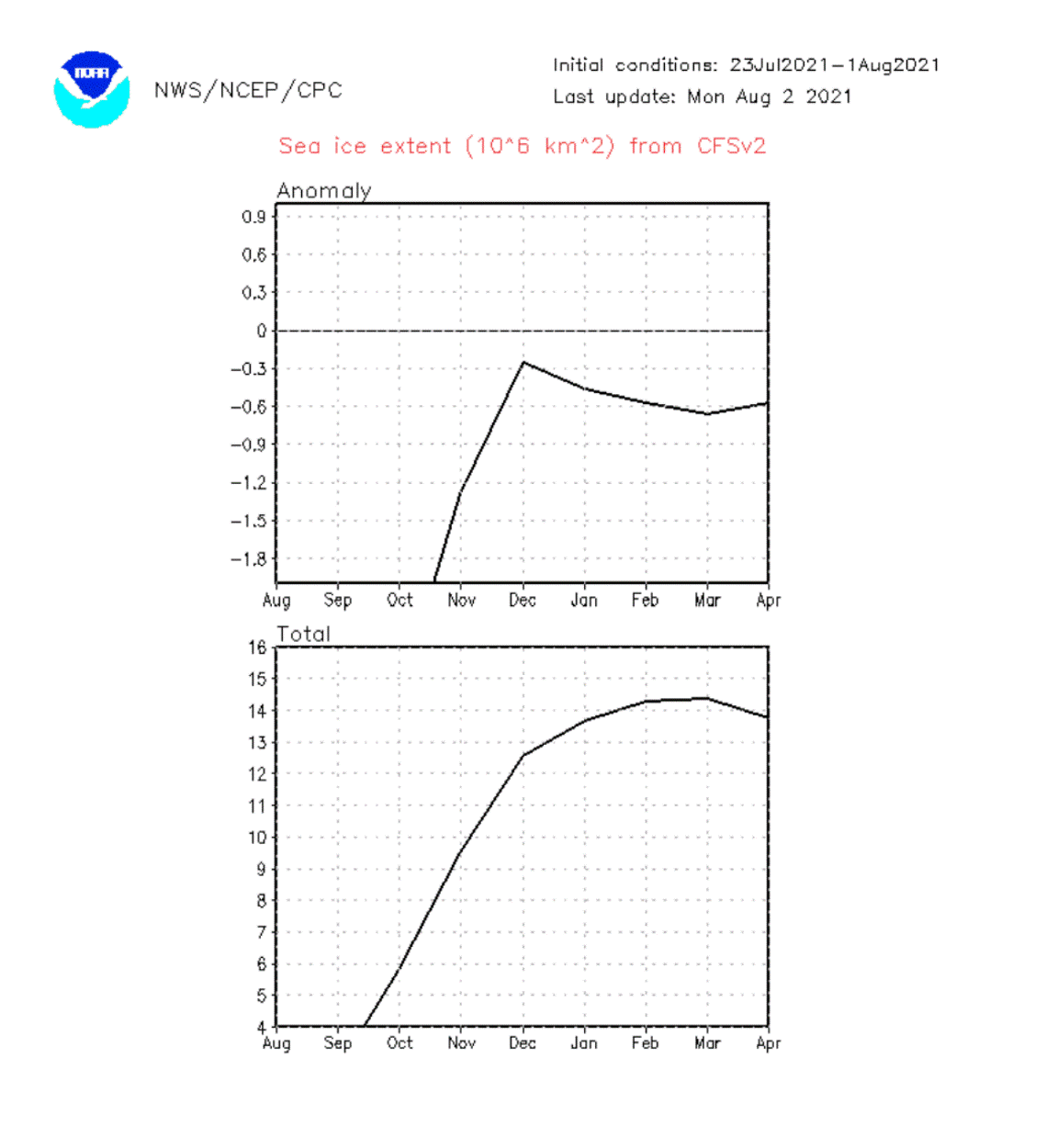
A blue ocean event would be declared if the Arctic sea ice extent ever reached just 1 million km² or less. It practically means an almost ice-free Arctic ocean, hence the name “blue ocean event”.
Below is the actual forecast of the Arctic sea ice concentration in September. We tend to focus on September, as it is the month when the sea ice area is at its lowest point. This forecast shows a very small sea ice area, but larger than the same forecasts in May and June.

The lowest value so far was reached in September 2012, at just 3.4 million square kilometers. The second-lowest Arctic sea ice extent was reached last year, at around 3.8 million square kilometers. You can just see the 2021 season now starting to appear on the graph. We will monitor closely how low it will drop in September.
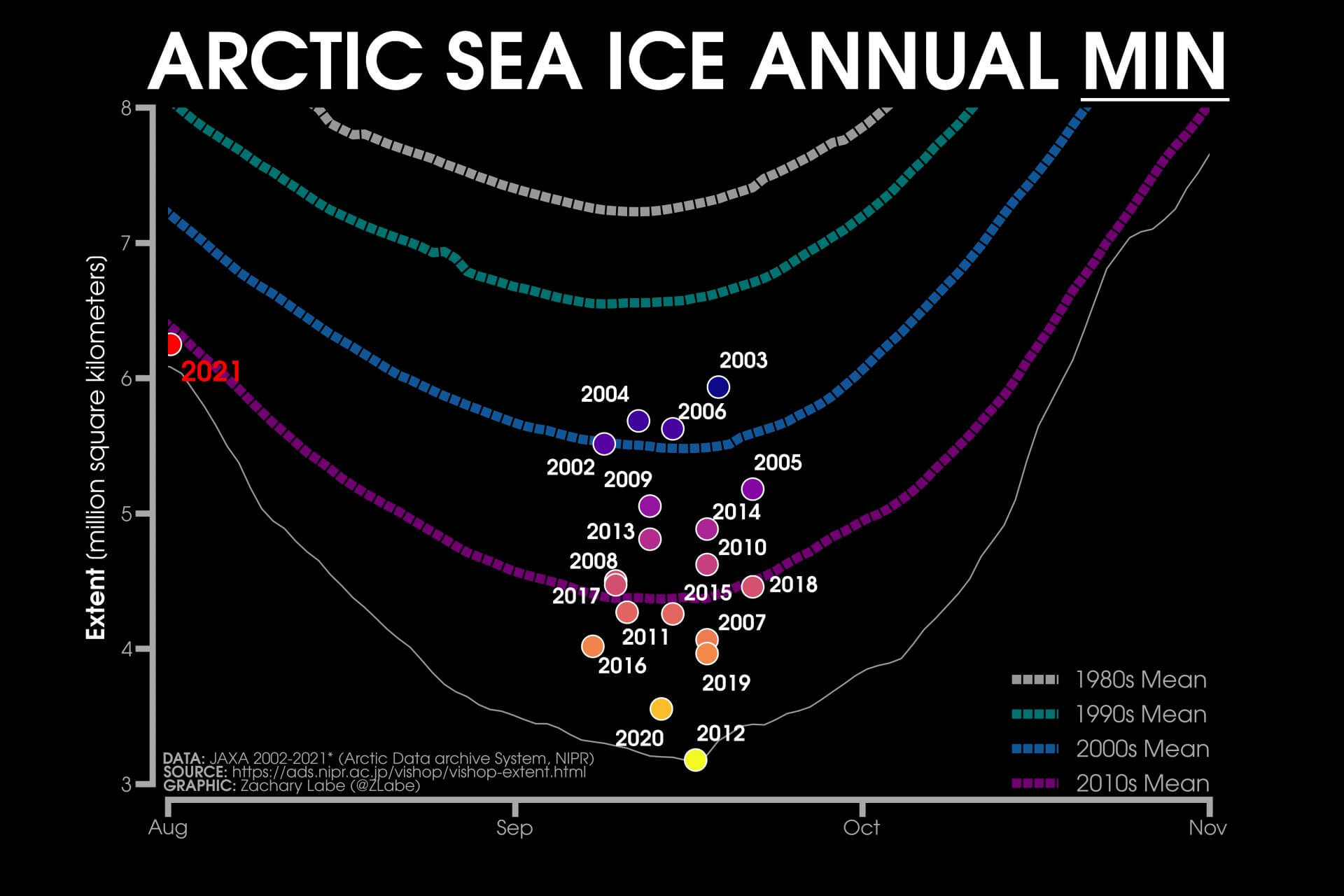
Below we have a map which shows the lowest sea ice extent in the modern records, reached in mid-September 2012. This is still around a similar size as the September 2021 forecast above by the CFSv2 model.
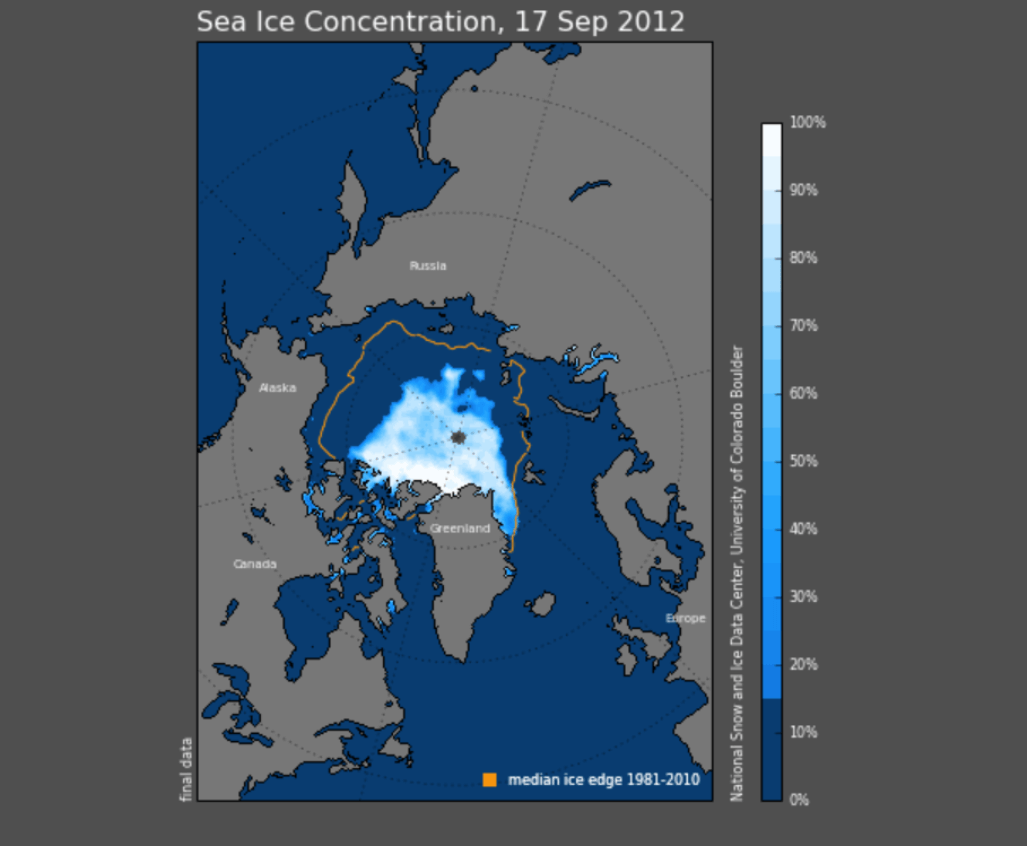
ANTARCTIC SEA ICE MELT SEASON
While the Arctic is losing its sea ice in summer, Antarctica is currently in its winter and is still gaining its sea ice. We will look at some latest data for Antarctica below, and some long-term trends.
Looking at the actual extent analysis, we can see that most areas show a larger sea ice extent than the long-term average (orange line), except for some loss in the western and southern regions.
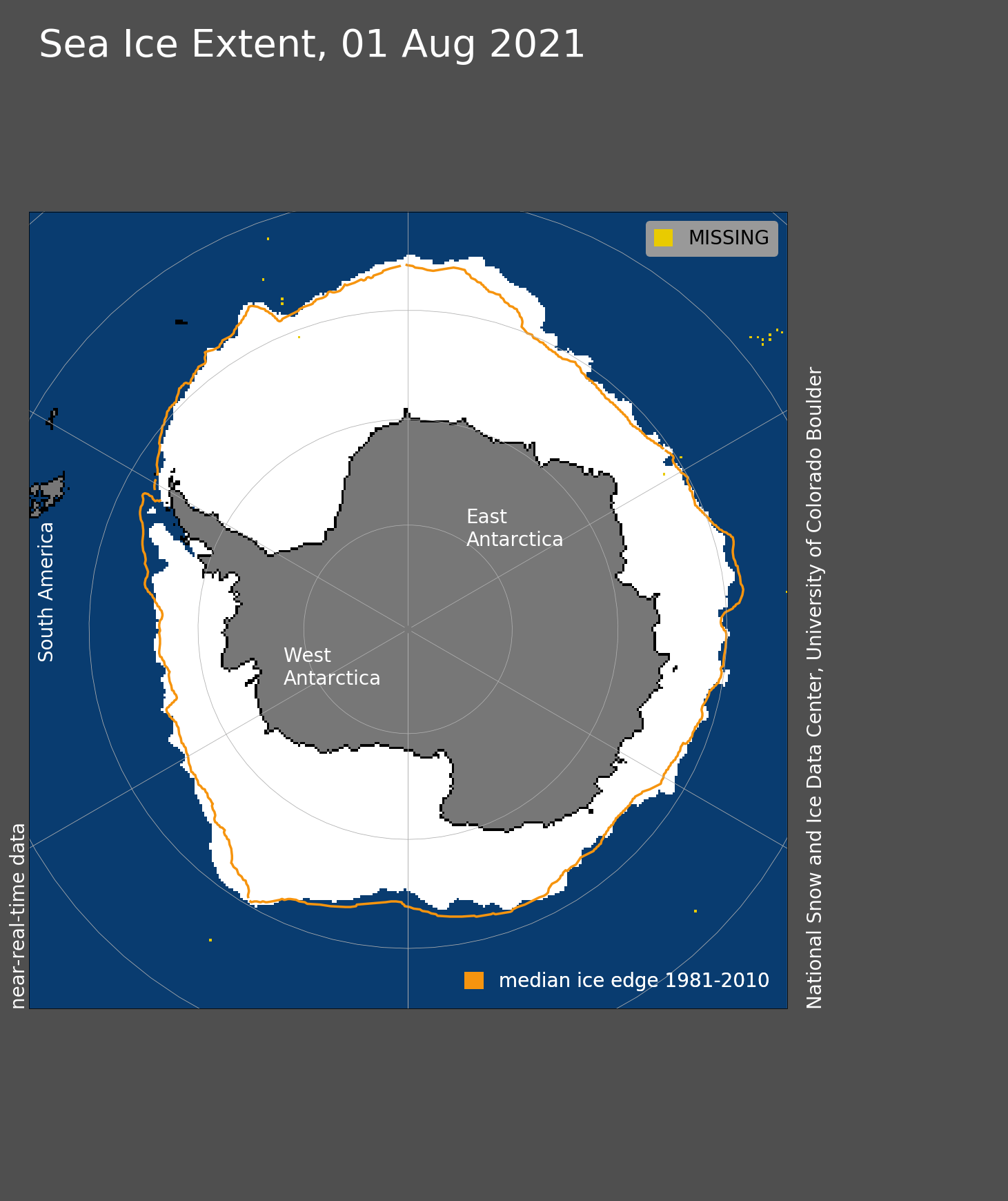

The extent analysis reveals the rapid ocean freezing from June and into July, keeping the sea ice extent well above the long-term average.
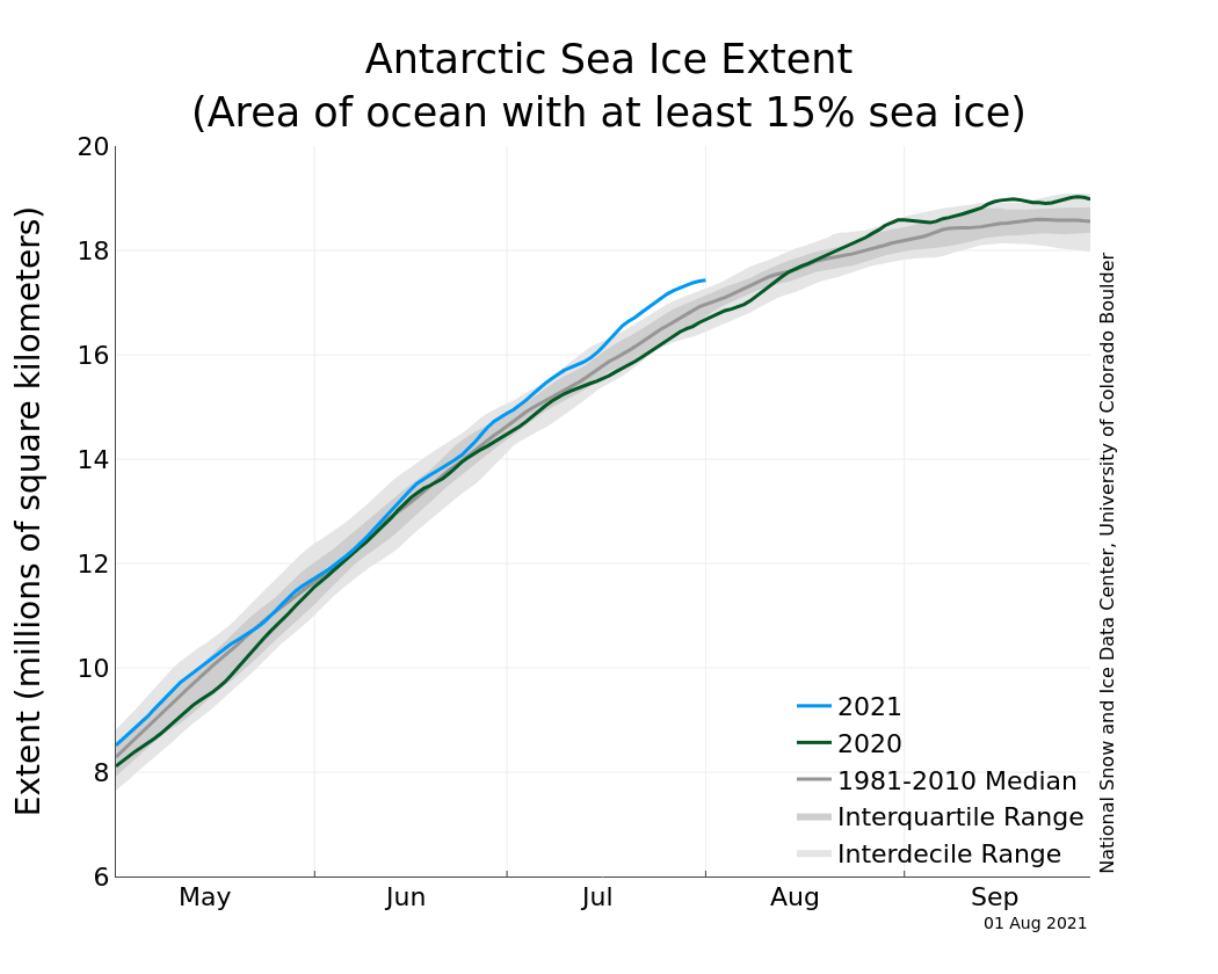
Looking at the June 2021 conditions around the Antarctic, you can see that most of the outer edges were running above normal sea ice extent (blue anomaly) with some regions being below normal (red anomaly).

Overall, the June sea ice extent trends for Antarctica actually show an increasing trend from the 1980s to 2015. since then there were a few years with the lowest June sea ice extent in the past 40 years.

We will keep you updated on the global ice and ocean conditions, so make sure to bookmark our page. Also, if you have seen this article in the Google App (Discover) feed, click the like button (♥) there to see more of our forecasts and our latest articles on weather and nature in general.
SEE ALSO: